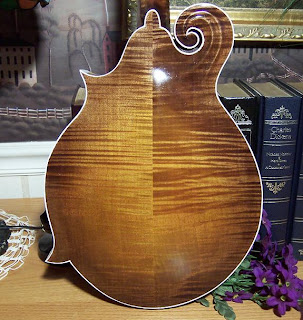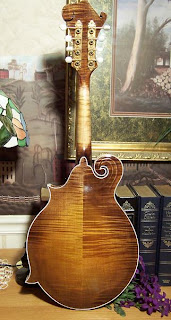Thursday, November 19, 2009
Well, it’s finally finished. And much to my surprise and pleasure, it sounds good, too.
Here are some photos.
I must say it’s been a heck of a ride. I’m glad I took it and I hope everyone has enjoyed it with me. Now I’m looking forward to learning to play this for a while and then - you guessed it - get started on #2.
Thursday, November 19, 2009
Saturday, October 24, 2009
Short Update...
Saturday, October 24, 2009
Not much to report - I’ve been doing a lot of traveling as of late so I haven't had a whole lot of time to devote to this project. What little time I have had has been dedicated to scraping binding and applying finish.
I got to thinking after a comment from Wilbur in my previous post, that maybe one of the reasons I am having so much difficulty with hand-applying lacquer (runs, smudges, long drying times) is that I have been too impatient and have been applying it much to thickly and working it for much too long. So recently I started working the lacquer using a much smaller applicator (a small piece of t-shirt material folded twice) to soak up less, and applying it in very thin coats.
Working like this for several coats has proven to be the ticket, at least for me. Sure the first couple of coats on bare wood don’t give the glossy results I want in the end, but after a couple more coats I am now getting much closer to the results I am wanting. Hopefully, after I add a few more coats to some target areas, I’ll soon be ready to fit the bridge and string ‘er up.
Not much to report - I’ve been doing a lot of traveling as of late so I haven't had a whole lot of time to devote to this project. What little time I have had has been dedicated to scraping binding and applying finish.
I got to thinking after a comment from Wilbur in my previous post, that maybe one of the reasons I am having so much difficulty with hand-applying lacquer (runs, smudges, long drying times) is that I have been too impatient and have been applying it much to thickly and working it for much too long. So recently I started working the lacquer using a much smaller applicator (a small piece of t-shirt material folded twice) to soak up less, and applying it in very thin coats.
Working like this for several coats has proven to be the ticket, at least for me. Sure the first couple of coats on bare wood don’t give the glossy results I want in the end, but after a couple more coats I am now getting much closer to the results I am wanting. Hopefully, after I add a few more coats to some target areas, I’ll soon be ready to fit the bridge and string ‘er up.
Labels:
finishing,
lacquer,
mandolin,
mandolin building
Saturday, October 3, 2009
Starting the Finishing Process
Saturday, October 03, 2009
Well, aside from getting the soundboard soundboard restained, there is not much to report for the last couple of weeks. This is not because I haven’t been doing anything, you understand, its because successfully applying the finish is NOT an easy process. All I can say at this point is that as one of my purchases for my next mandolin, I am going to get a book and/or a video on finishing. Stewart-MacDonald offers a couple of choices including Complete Illustrated Guide to Finishing by Jeff Jewitt that I think I will probably get. Before I do, though, I will see what the folks at the Mandolin Cafe think.
In any case, I figured I would share a couple of pictures of the re-staining I was able to get after having to remove my first finishing attempt.
As you can see it came out really well, or at least I think so.
I don’t expect to post much for a while since one of the things I have learned is that I will be applying (and re-applying after messing up) several coats of lacquer by the time this is done and that lacquer has to cure for a couple of weeks before it truly sets up. There is so little to see and so much waiting that I really don’t have much to offer. About the only things I have left to do are to make a truss rod cover, fit the bridge, install and end-pin, and string-her up. None of that can really be done until the finish has cured.
I have also found that since I am hand-applying my finish it is difficult, if not impossible, to apply lacquer to both the front and back on the same day. Consequently I am forced to work on one side for a bit, wait for at least a day so that can dry and then work on the other. I’m guessing that it will be several weeks before I finally have the finish I want before I can move to fitting the bridge.
Well, aside from getting the soundboard soundboard restained, there is not much to report for the last couple of weeks. This is not because I haven’t been doing anything, you understand, its because successfully applying the finish is NOT an easy process. All I can say at this point is that as one of my purchases for my next mandolin, I am going to get a book and/or a video on finishing. Stewart-MacDonald offers a couple of choices including Complete Illustrated Guide to Finishing by Jeff Jewitt that I think I will probably get. Before I do, though, I will see what the folks at the Mandolin Cafe think.
In any case, I figured I would share a couple of pictures of the re-staining I was able to get after having to remove my first finishing attempt.
As you can see it came out really well, or at least I think so.
I don’t expect to post much for a while since one of the things I have learned is that I will be applying (and re-applying after messing up) several coats of lacquer by the time this is done and that lacquer has to cure for a couple of weeks before it truly sets up. There is so little to see and so much waiting that I really don’t have much to offer. About the only things I have left to do are to make a truss rod cover, fit the bridge, install and end-pin, and string-her up. None of that can really be done until the finish has cured.
I have also found that since I am hand-applying my finish it is difficult, if not impossible, to apply lacquer to both the front and back on the same day. Consequently I am forced to work on one side for a bit, wait for at least a day so that can dry and then work on the other. I’m guessing that it will be several weeks before I finally have the finish I want before I can move to fitting the bridge.
Monday, September 21, 2009
Staining the Soundboard and Learning A Lesson
Monday, September 21, 2009
Ah, the never ending learning curve. Sometimes I wonder if I am on it or under it. You work so hard at something, read up on it, do tests and trials, and then turn around and mess it up.
But enough on that - I will come back to it soon enough.
Yesterday, as I said I would, I took the plunge and applied my stain to the front - and I really liked the results.
 As you can see, not only was I able to achieve a nice balance between the dark-to-light transition in my sunburst, but I was also able to get the outside edge pretty dark without leaving the light-colored ring like I did on my test pieces. Here is how I did it:
As you can see, not only was I able to achieve a nice balance between the dark-to-light transition in my sunburst, but I was also able to get the outside edge pretty dark without leaving the light-colored ring like I did on my test pieces. Here is how I did it:
 First I set myself up with four clean glass cups, plenty of water (I’m using water-based dye, as you will recall), four swabs and plenty of clean rags. In three of the four cups, I will be mixing stains, from left to right, dark Tobacco Brown, Amber, and a Tobacco Brown with just a little bit of Cherry Red. In the fourth cup I will leave plain water. A swab is dedicated for each cup.
First I set myself up with four clean glass cups, plenty of water (I’m using water-based dye, as you will recall), four swabs and plenty of clean rags. In three of the four cups, I will be mixing stains, from left to right, dark Tobacco Brown, Amber, and a Tobacco Brown with just a little bit of Cherry Red. In the fourth cup I will leave plain water. A swab is dedicated for each cup.
 After preparing all three stain mixtures, I started by staining the entire soundboard Amber.
After preparing all three stain mixtures, I started by staining the entire soundboard Amber.
 Next, I added a ring of Tobacco Brown around the outside edge and feathered it in toward the center. Because the wood was a bit wet from the Amber, the Brown did not soak in very deeply, but this is ok since all I want is for it to act as a transition to the dark Red/Brown I will apply next.
Next, I added a ring of Tobacco Brown around the outside edge and feathered it in toward the center. Because the wood was a bit wet from the Amber, the Brown did not soak in very deeply, but this is ok since all I want is for it to act as a transition to the dark Red/Brown I will apply next.
 Finally, I applied the Red/Brown and, again, feathered it in toward the center, but not as far in as I did the Brown.
Finally, I applied the Red/Brown and, again, feathered it in toward the center, but not as far in as I did the Brown.
Once all the stains was applied, I touched up a little by using plain water and working outward from the center to push back some of the darkness and to lighten the Amber a bit. I also found that letting the swab with the Red/Brown dry out so that it only marked lightly on the wood gave me a great medium for applying minor color touch-ups without having to work very hard to blend afterward.
At this point (about the point where I took the composite photos above), I realized I needed to do some additional staining on the back and sides in order to make them more readily match the front. I did that and by that time it was about mid-day, so I decided to let the whole instrument dry for the afternoon.
Just before bed-time I decided to apply a coat of Shellac as a sealer, let that dry overnight, and then come back today to begin applying my finish coats of lacquer.
And here is where I got bit.
When I bought my can of shellac, I also bought some of those sponge-type paint brushes to use to apply it. I figures this should be a pretty straight-forward process, take only a few minutes, and that these brushes would work just fine.
Wrong.
Not only was it a mistake to think that sponge brushes were the way to apply this stuff, but shellac from a can, I quickly learned, is also quite thin (read “runny”) and it dries in a matter of minutes. So now I am working with a substance that is almost impossible for a beginner to get in all the right places, in all the right thicknesses, in anything like a timely manner. And furthermore, if you put it on too thick, it lifts the stain and redistributes it for you. Really.
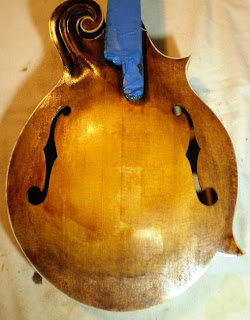
 I’m here to tell you, this is no way to end your day, especially when the next thing on the agenda is to climb into bed. It makes for a really hard time trying to fall asleep and then when you do, I assure you, you will not have the very best of dreams.
I’m here to tell you, this is no way to end your day, especially when the next thing on the agenda is to climb into bed. It makes for a really hard time trying to fall asleep and then when you do, I assure you, you will not have the very best of dreams.
Clearly, the only thing to do - short of using it as kindling - is to strip off all of the shellac and stain and try again. Assuming of coarse that I can.
So today on my way home from work, I stopped by Lowe’s again and picked up a can of denatured alcohol. According to the blurb on the can, this is the right stuff for removing shellac from brushes so, surely, its the right stuff for removing from my mandolin.
I also picked up a new can of spray-on shellac.
This evening then, using generous quantities of the alcohol and a bunch of rags, I was able to remove pretty much all of the shellac and stain from the soundboard. Here is how it looks as of tonight.
 I was pleasantly surprised to find that when removing the shellac from the back and the sides, almost none of the stain was removed with it. In fact, whatever stain might have been removed seems to have improved the appearance.
I was pleasantly surprised to find that when removing the shellac from the back and the sides, almost none of the stain was removed with it. In fact, whatever stain might have been removed seems to have improved the appearance.
That’s it for tonight. I plan to let everything air-out until tomorrow evening when I will attempt to stain to the soundboard again and then, should that go well, on Wednesday (not just before bedtime on Tuesday) I will spray on thin coat of shellac as a sealer.
Ah, the never ending learning curve. Sometimes I wonder if I am on it or under it. You work so hard at something, read up on it, do tests and trials, and then turn around and mess it up.
But enough on that - I will come back to it soon enough.
Yesterday, as I said I would, I took the plunge and applied my stain to the front - and I really liked the results.
 As you can see, not only was I able to achieve a nice balance between the dark-to-light transition in my sunburst, but I was also able to get the outside edge pretty dark without leaving the light-colored ring like I did on my test pieces. Here is how I did it:
As you can see, not only was I able to achieve a nice balance between the dark-to-light transition in my sunburst, but I was also able to get the outside edge pretty dark without leaving the light-colored ring like I did on my test pieces. Here is how I did it: First I set myself up with four clean glass cups, plenty of water (I’m using water-based dye, as you will recall), four swabs and plenty of clean rags. In three of the four cups, I will be mixing stains, from left to right, dark Tobacco Brown, Amber, and a Tobacco Brown with just a little bit of Cherry Red. In the fourth cup I will leave plain water. A swab is dedicated for each cup.
First I set myself up with four clean glass cups, plenty of water (I’m using water-based dye, as you will recall), four swabs and plenty of clean rags. In three of the four cups, I will be mixing stains, from left to right, dark Tobacco Brown, Amber, and a Tobacco Brown with just a little bit of Cherry Red. In the fourth cup I will leave plain water. A swab is dedicated for each cup. Next, I added a ring of Tobacco Brown around the outside edge and feathered it in toward the center. Because the wood was a bit wet from the Amber, the Brown did not soak in very deeply, but this is ok since all I want is for it to act as a transition to the dark Red/Brown I will apply next.
Next, I added a ring of Tobacco Brown around the outside edge and feathered it in toward the center. Because the wood was a bit wet from the Amber, the Brown did not soak in very deeply, but this is ok since all I want is for it to act as a transition to the dark Red/Brown I will apply next.Once all the stains was applied, I touched up a little by using plain water and working outward from the center to push back some of the darkness and to lighten the Amber a bit. I also found that letting the swab with the Red/Brown dry out so that it only marked lightly on the wood gave me a great medium for applying minor color touch-ups without having to work very hard to blend afterward.
At this point (about the point where I took the composite photos above), I realized I needed to do some additional staining on the back and sides in order to make them more readily match the front. I did that and by that time it was about mid-day, so I decided to let the whole instrument dry for the afternoon.
Just before bed-time I decided to apply a coat of Shellac as a sealer, let that dry overnight, and then come back today to begin applying my finish coats of lacquer.
And here is where I got bit.
When I bought my can of shellac, I also bought some of those sponge-type paint brushes to use to apply it. I figures this should be a pretty straight-forward process, take only a few minutes, and that these brushes would work just fine.
Wrong.
Not only was it a mistake to think that sponge brushes were the way to apply this stuff, but shellac from a can, I quickly learned, is also quite thin (read “runny”) and it dries in a matter of minutes. So now I am working with a substance that is almost impossible for a beginner to get in all the right places, in all the right thicknesses, in anything like a timely manner. And furthermore, if you put it on too thick, it lifts the stain and redistributes it for you. Really.
 I’m here to tell you, this is no way to end your day, especially when the next thing on the agenda is to climb into bed. It makes for a really hard time trying to fall asleep and then when you do, I assure you, you will not have the very best of dreams.
I’m here to tell you, this is no way to end your day, especially when the next thing on the agenda is to climb into bed. It makes for a really hard time trying to fall asleep and then when you do, I assure you, you will not have the very best of dreams.Clearly, the only thing to do - short of using it as kindling - is to strip off all of the shellac and stain and try again. Assuming of coarse that I can.
So today on my way home from work, I stopped by Lowe’s again and picked up a can of denatured alcohol. According to the blurb on the can, this is the right stuff for removing shellac from brushes so, surely, its the right stuff for removing from my mandolin.
I also picked up a new can of spray-on shellac.
This evening then, using generous quantities of the alcohol and a bunch of rags, I was able to remove pretty much all of the shellac and stain from the soundboard. Here is how it looks as of tonight.
 I was pleasantly surprised to find that when removing the shellac from the back and the sides, almost none of the stain was removed with it. In fact, whatever stain might have been removed seems to have improved the appearance.
I was pleasantly surprised to find that when removing the shellac from the back and the sides, almost none of the stain was removed with it. In fact, whatever stain might have been removed seems to have improved the appearance.That’s it for tonight. I plan to let everything air-out until tomorrow evening when I will attempt to stain to the soundboard again and then, should that go well, on Wednesday (not just before bedtime on Tuesday) I will spray on thin coat of shellac as a sealer.
Labels:
alcohol,
mandolin building,
soundboard,
staining
Saturday, September 19, 2009
Staining the Back & Pre-Staining the Soundboard
Saturday, September 19, 2009
Since my last post I have finished staining the back and am really happy with the results and have spent a considerable amount of energy testing and researching how to stain the soundboard without ruining it - and I think I have figured it out.
First, lets take a look at the back.
As you will recall, I left you last time with the back and sides stained once with my Tobacco Brown stain and then sanded it off in order to bring out the shimmer of the maple. From there, I applied my finish stain.
 I started by applying the Tobacco Brown around the outside edge and then feathered it up toward the center where no stain is yet applied.
I started by applying the Tobacco Brown around the outside edge and then feathered it up toward the center where no stain is yet applied.
 Then, starting from the center, I applied Amber stain and worked my way out. When done (a pretty easy process, really), the hardest part was making the transition from dark to light smooth and not to dramatic.
Then, starting from the center, I applied Amber stain and worked my way out. When done (a pretty easy process, really), the hardest part was making the transition from dark to light smooth and not to dramatic.
Then it was time to start working on the test wood again to figure out how to stain the soundboard. As you may recall, I tried this once on my first junk soundboard and was not at all happy with the results. When I tried again this time, instead of preparing the wood with a hide-glue solution, I tried it without any preparation other than sanding. Sadly, as with the previous attempt, I hated the results. Here is what some of those looked like:
 In this composite shot, the lower left area is actually a bit of a success since it shows where I made an attempt after applying a pre-stain (I will get to that in a minute). The other three areas show where the stain has been absorbed by the wood in way-too-random of fashion. My goal is to get a much more even distribution.
In this composite shot, the lower left area is actually a bit of a success since it shows where I made an attempt after applying a pre-stain (I will get to that in a minute). The other three areas show where the stain has been absorbed by the wood in way-too-random of fashion. My goal is to get a much more even distribution.
 This shot shows my second sunburst staining attempt (disappointing) as well as where I am testing of my top coat.
This shot shows my second sunburst staining attempt (disappointing) as well as where I am testing of my top coat.
Time to go back to the Mandolin Cafe again and do some research.
After reading many threads in the Cafe’s “Builder’s” forum, it became apparent that hand-rubbing a sunburst stain on a spruce soundboard is difficult, at best. Many of the pros have a hard time with it and some don’t even bother with doing it by hand but use an airbrush instead.
I don’t have an airbrush. And even if I did, I don’t have a place (or the knowledge) to use it.
In addition to this, however, I did learn a couple of ways to improve my chances of success.
First way is sanding. The level of sanding, the thoroughness of it and the attention to this bit of detail is CRITICAL to the success of hand-rubbing a sunburst stain. I already knew it was important to get rid of all the scratches left from rougher grit papers and scraping marks, but what I did not know was that sanding to too-fine of a grit is not good, either. By stopping at 220 grit, the surface of the spruce is left a bit “fuzzy” (I see this under my magnifying glass) allowing the less porous areas of the wood to absorb more of the stain, more like the way the end-grains do. On my two full-soundboard test attempts I had sanded down to 600 grit so for my smaller test areas I sanded again to a 220 grit.
The other way is to find and apply a store-bought Pre-Stain. Using a pre-stain apparently seals the end-grains enough to prevent the stain from soaking in too much, but not enough to prevent it from soaking in at all. The result should be to allow for a more even distribution of stain across both end-grains and straight-grains.
I attempted to make my own pre-stain on my first test using the hide-glue, but not having a good idea how to handle it and a fear that the glue itself would prevent the stain from “taking”, I might have sanded too much of it off again before applying my stain. In any case, that attempt did not work, so I went out and bought a can of Min-Wax Pre-Stain that is especially made for water-based stains.
 Here is how one area of one of my soundboards looked after using the Min-Wax Pre-Stain:
Here is how one area of one of my soundboards looked after using the Min-Wax Pre-Stain:
 As you can see, not only is the light-colored ring no longer there (this I attribute mostly to rougher sanding), but the end-grain has taken a lot less stain than it did the first time. It took a whole lot less effort to get this result, too.
As you can see, not only is the light-colored ring no longer there (this I attribute mostly to rougher sanding), but the end-grain has taken a lot less stain than it did the first time. It took a whole lot less effort to get this result, too.
So, now that I have a technique that looks like it will work, I will be staining my soundboard for real this weekend. This is how I am doing it.
 Here is the soundboard before applying anything to it. I have sanded it down to 220 grit, wetted it twice to raise the grain and then re-sanded.
Here is the soundboard before applying anything to it. I have sanded it down to 220 grit, wetted it twice to raise the grain and then re-sanded.
 Using old T-shirt material, both inside and out, I have created a “swab” as an applicator. This is the same kind of swab I am using for applying my stain and finish later.
Using old T-shirt material, both inside and out, I have created a “swab” as an applicator. This is the same kind of swab I am using for applying my stain and finish later.
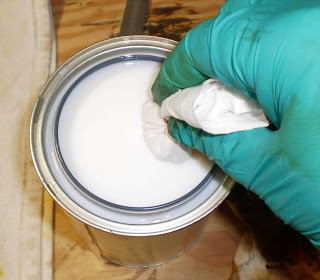

 I find that the wood appears to soak this stuff right up, so I will be applying two coats of it. These photos are of my first coat and I have let it dry over-night. This morning I applied my second coat (that appears to have soaked in every bit as quickly as the first one) and will wait at least until this afternoon before attempting to apply the stain.
I find that the wood appears to soak this stuff right up, so I will be applying two coats of it. These photos are of my first coat and I have let it dry over-night. This morning I applied my second coat (that appears to have soaked in every bit as quickly as the first one) and will wait at least until this afternoon before attempting to apply the stain.
Since my last post I have finished staining the back and am really happy with the results and have spent a considerable amount of energy testing and researching how to stain the soundboard without ruining it - and I think I have figured it out.
First, lets take a look at the back.
As you will recall, I left you last time with the back and sides stained once with my Tobacco Brown stain and then sanded it off in order to bring out the shimmer of the maple. From there, I applied my finish stain.
Then it was time to start working on the test wood again to figure out how to stain the soundboard. As you may recall, I tried this once on my first junk soundboard and was not at all happy with the results. When I tried again this time, instead of preparing the wood with a hide-glue solution, I tried it without any preparation other than sanding. Sadly, as with the previous attempt, I hated the results. Here is what some of those looked like:
 In this composite shot, the lower left area is actually a bit of a success since it shows where I made an attempt after applying a pre-stain (I will get to that in a minute). The other three areas show where the stain has been absorbed by the wood in way-too-random of fashion. My goal is to get a much more even distribution.
In this composite shot, the lower left area is actually a bit of a success since it shows where I made an attempt after applying a pre-stain (I will get to that in a minute). The other three areas show where the stain has been absorbed by the wood in way-too-random of fashion. My goal is to get a much more even distribution.Time to go back to the Mandolin Cafe again and do some research.
After reading many threads in the Cafe’s “Builder’s” forum, it became apparent that hand-rubbing a sunburst stain on a spruce soundboard is difficult, at best. Many of the pros have a hard time with it and some don’t even bother with doing it by hand but use an airbrush instead.
I don’t have an airbrush. And even if I did, I don’t have a place (or the knowledge) to use it.
In addition to this, however, I did learn a couple of ways to improve my chances of success.
First way is sanding. The level of sanding, the thoroughness of it and the attention to this bit of detail is CRITICAL to the success of hand-rubbing a sunburst stain. I already knew it was important to get rid of all the scratches left from rougher grit papers and scraping marks, but what I did not know was that sanding to too-fine of a grit is not good, either. By stopping at 220 grit, the surface of the spruce is left a bit “fuzzy” (I see this under my magnifying glass) allowing the less porous areas of the wood to absorb more of the stain, more like the way the end-grains do. On my two full-soundboard test attempts I had sanded down to 600 grit so for my smaller test areas I sanded again to a 220 grit.
The other way is to find and apply a store-bought Pre-Stain. Using a pre-stain apparently seals the end-grains enough to prevent the stain from soaking in too much, but not enough to prevent it from soaking in at all. The result should be to allow for a more even distribution of stain across both end-grains and straight-grains.
I attempted to make my own pre-stain on my first test using the hide-glue, but not having a good idea how to handle it and a fear that the glue itself would prevent the stain from “taking”, I might have sanded too much of it off again before applying my stain. In any case, that attempt did not work, so I went out and bought a can of Min-Wax Pre-Stain that is especially made for water-based stains.
 Here is how one area of one of my soundboards looked after using the Min-Wax Pre-Stain:
Here is how one area of one of my soundboards looked after using the Min-Wax Pre-Stain:So, now that I have a technique that looks like it will work, I will be staining my soundboard for real this weekend. This is how I am doing it.
 Using old T-shirt material, both inside and out, I have created a “swab” as an applicator. This is the same kind of swab I am using for applying my stain and finish later.
Using old T-shirt material, both inside and out, I have created a “swab” as an applicator. This is the same kind of swab I am using for applying my stain and finish later.
Labels:
mandolin building,
Pre-stain,
soundboard,
spruce,
stain,
staining
Tuesday, September 8, 2009
First Staining Coat
Tuesday, September 8, 2009
The long weekend presented an opportunity to get some work done, so I went ahead and did some initial stain work.
Since my last post, I have spent a number of hours sanding and sanding. I gotta say, its amazing how much sanding there is to do. You would think that for an instrument that is so small that this wouldn’t be such a large time consumer, but it really is. Every time you get done with one area, another presents itself. Then, once you finished with that, its time to drop to a finer grit and do it all over again. But, even so, the results are worth it. I really love the way the wood feels when finally sanded to a 600 grit – very smooth.
While pictures really don’t do it justice, IMHO, here are some shots “in the white”.






 So before I got to staining, I decided to go back to review a video I had seen about how to create a sunburst stain effect on a mandolin. I had found THIS VIDEO from Fine Woodworking by James Condino once before and decided I would try to use his techniques.
So before I got to staining, I decided to go back to review a video I had seen about how to create a sunburst stain effect on a mandolin. I had found THIS VIDEO from Fine Woodworking by James Condino once before and decided I would try to use his techniques.
To begin, I started on the back and, using the Charcoal Brown dye, began by rubbing this in to enhance the “quilted” effect of the maple. Here are some before, during, and after shots.
 This is really just another shot of “in-the-white” for comparison.
This is really just another shot of “in-the-white” for comparison.
 Here I have rubbed the back down with water, as Mr. Condino suggests, to prevent too much dye from getting in too deeply to work with.
Here I have rubbed the back down with water, as Mr. Condino suggests, to prevent too much dye from getting in too deeply to work with.
 Here I have rubbed in the stain across the entire surface of the wood (in hindsight, I believe I put down too much, but I don’t think it ended up creating an issue – I will use less and thinner on my next mando).
Here I have rubbed in the stain across the entire surface of the wood (in hindsight, I believe I put down too much, but I don’t think it ended up creating an issue – I will use less and thinner on my next mando).
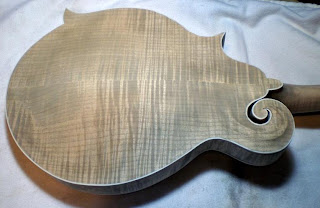 And, finally, here is how it looked after sanding off the majority of stain. Its kind of hard to see the difference in this photo, but when I hold it up and move it around, there appears to be more “depth” to the wood now.
And, finally, here is how it looked after sanding off the majority of stain. Its kind of hard to see the difference in this photo, but when I hold it up and move it around, there appears to be more “depth” to the wood now.
Similar to the back, I chose to do the same to both the sides, neck, and the peghead (I went lighter on the neck since I want it to be almost white in the long run). Here is how they looked.

 With these two, you can get an idea how this will look when it’s finished. I’m pretty psyched.
With these two, you can get an idea how this will look when it’s finished. I’m pretty psyched.

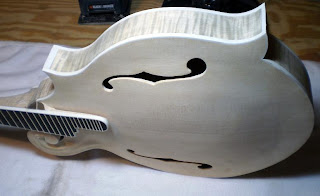 And once again, the pictures don’t really tell the tale – the “depth” is pretty cool.
And once again, the pictures don’t really tell the tale – the “depth” is pretty cool.
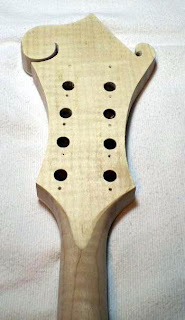

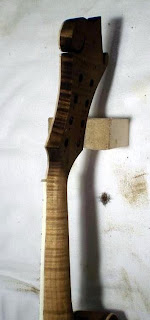

 I’m really going to be interested in how the back of the peghead comes out. After sanding off the stain, it has some of the quilted effect, but not like the body and sides (it is a veneer, if you recall). If I don’t like it, I figure I can always stain it really dark – the tuners will just stand out more that way.
I’m really going to be interested in how the back of the peghead comes out. After sanding off the stain, it has some of the quilted effect, but not like the body and sides (it is a veneer, if you recall). If I don’t like it, I figure I can always stain it really dark – the tuners will just stand out more that way.
Well that’s about it for now. I still plan to try my hand with the sunburst on the one remaining spare soundboard I have before I commit to the mandolin, so hopefully I can show you that next time.
The long weekend presented an opportunity to get some work done, so I went ahead and did some initial stain work.
Since my last post, I have spent a number of hours sanding and sanding. I gotta say, its amazing how much sanding there is to do. You would think that for an instrument that is so small that this wouldn’t be such a large time consumer, but it really is. Every time you get done with one area, another presents itself. Then, once you finished with that, its time to drop to a finer grit and do it all over again. But, even so, the results are worth it. I really love the way the wood feels when finally sanded to a 600 grit – very smooth.
While pictures really don’t do it justice, IMHO, here are some shots “in the white”.

 So before I got to staining, I decided to go back to review a video I had seen about how to create a sunburst stain effect on a mandolin. I had found THIS VIDEO from Fine Woodworking by James Condino once before and decided I would try to use his techniques.
So before I got to staining, I decided to go back to review a video I had seen about how to create a sunburst stain effect on a mandolin. I had found THIS VIDEO from Fine Woodworking by James Condino once before and decided I would try to use his techniques.To begin, I started on the back and, using the Charcoal Brown dye, began by rubbing this in to enhance the “quilted” effect of the maple. Here are some before, during, and after shots.
 This is really just another shot of “in-the-white” for comparison.
This is really just another shot of “in-the-white” for comparison. Here I have rubbed in the stain across the entire surface of the wood (in hindsight, I believe I put down too much, but I don’t think it ended up creating an issue – I will use less and thinner on my next mando).
Here I have rubbed in the stain across the entire surface of the wood (in hindsight, I believe I put down too much, but I don’t think it ended up creating an issue – I will use less and thinner on my next mando).Similar to the back, I chose to do the same to both the sides, neck, and the peghead (I went lighter on the neck since I want it to be almost white in the long run). Here is how they looked.

 With these two, you can get an idea how this will look when it’s finished. I’m pretty psyched.
With these two, you can get an idea how this will look when it’s finished. I’m pretty psyched.
 I’m really going to be interested in how the back of the peghead comes out. After sanding off the stain, it has some of the quilted effect, but not like the body and sides (it is a veneer, if you recall). If I don’t like it, I figure I can always stain it really dark – the tuners will just stand out more that way.
I’m really going to be interested in how the back of the peghead comes out. After sanding off the stain, it has some of the quilted effect, but not like the body and sides (it is a veneer, if you recall). If I don’t like it, I figure I can always stain it really dark – the tuners will just stand out more that way.Well that’s about it for now. I still plan to try my hand with the sunburst on the one remaining spare soundboard I have before I commit to the mandolin, so hopefully I can show you that next time.
Sunday, August 30, 2009
Finished Binding and Trimming the Bridge
Sunday, August 30, 2009
I haven’t spent a lot of time on this project for the last few weeks - spending more time with family and work instead - so I have also been lax in updating this blog. But I have made some progress.
I strung up the mandolin and fully tuned it and, much to my pleasant surprise, the top did not collapse or even make any cracking noises, for that matter (as you may recall, I was worried about this since I managed to make my soundboard way too thin at the base and had to reinforce it). But while there was good news about the soundboard, there was also not-so-good news elsewhere; the action (distance from the strings to the fretboard) was WAY too high. Looking at it (sorry - no photos) you would have thought I hadn’t even tried to get it right. That was pretty disappointing. But I figured out how to handle it (I hope).
The bridge that I bought is made of two halves; the lower half that makes contact with the soundboard and the upper half that the strings rest upon. The two halves are then held together (and spaced apart in an adjustable fashion) by two thumbscrews. By cutting down the thickness of each of these two halves, I brought the action down to what I believe will be a workable distance.
 In this photo, you can see the mark on the upper half of the bridge where I then trimmed to - a lot of material to take off, I know! Similarly, I took off about half that much material from the lower piece. After trimming, I held a long straight edge between the nut and the bridge assembly and I think the height is just about right. I will have to wait until I string it up again to see for sure. I also have yet to shape the base of the bridge to the soundboard. That will reduce the height a even more.
In this photo, you can see the mark on the upper half of the bridge where I then trimmed to - a lot of material to take off, I know! Similarly, I took off about half that much material from the lower piece. After trimming, I held a long straight edge between the nut and the bridge assembly and I think the height is just about right. I will have to wait until I string it up again to see for sure. I also have yet to shape the base of the bridge to the soundboard. That will reduce the height a even more.
Aside from the bridge work, I also managed to finish gluing on the remainder of my binding and then trim it to height and width. The final pieces were on the peghead and this is how it looks now.
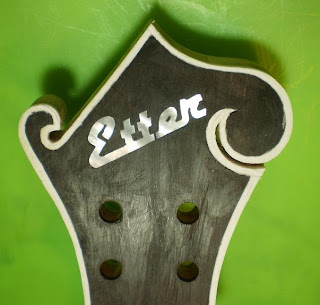
 I still have to do some fill-in work around the binding similar to what I did with the inlay and then a bunch of sanding, but I think it came out alright for my first attempt. Next time I intend to do several things differently (shape and bind the peghead veneer before gluing them in place, for starters) so that one should look much better.
I still have to do some fill-in work around the binding similar to what I did with the inlay and then a bunch of sanding, but I think it came out alright for my first attempt. Next time I intend to do several things differently (shape and bind the peghead veneer before gluing them in place, for starters) so that one should look much better.
With those completed, it has become time to get my finished sanding done in preparation for staining. I haven’t yet stained my second trial soundboard but after the results I got on my first trial, you can bet I will do the second before committing the mandolin itself to this.
I haven’t spent a lot of time on this project for the last few weeks - spending more time with family and work instead - so I have also been lax in updating this blog. But I have made some progress.
I strung up the mandolin and fully tuned it and, much to my pleasant surprise, the top did not collapse or even make any cracking noises, for that matter (as you may recall, I was worried about this since I managed to make my soundboard way too thin at the base and had to reinforce it). But while there was good news about the soundboard, there was also not-so-good news elsewhere; the action (distance from the strings to the fretboard) was WAY too high. Looking at it (sorry - no photos) you would have thought I hadn’t even tried to get it right. That was pretty disappointing. But I figured out how to handle it (I hope).
The bridge that I bought is made of two halves; the lower half that makes contact with the soundboard and the upper half that the strings rest upon. The two halves are then held together (and spaced apart in an adjustable fashion) by two thumbscrews. By cutting down the thickness of each of these two halves, I brought the action down to what I believe will be a workable distance.
Aside from the bridge work, I also managed to finish gluing on the remainder of my binding and then trim it to height and width. The final pieces were on the peghead and this is how it looks now.
With those completed, it has become time to get my finished sanding done in preparation for staining. I haven’t yet stained my second trial soundboard but after the results I got on my first trial, you can bet I will do the second before committing the mandolin itself to this.
Labels:
action,
binding,
bridge,
mandolin building,
soundboard
Subscribe to:
Posts (Atom)



